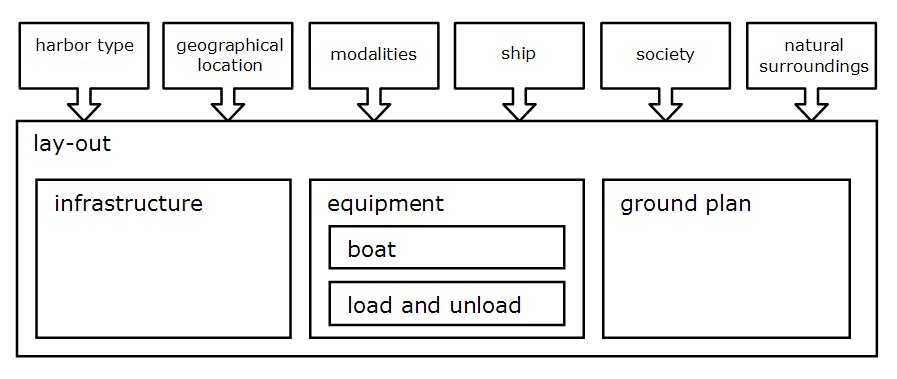
J.J. de Boer
Schematic overview of aspects influencing the design and construction of a ferry terminal
Literature survey,
Report 2004.TL.6942, Transport Engineering and Logistics.
The goal of this literature study is to give a schematic overview of the
aspects influencing the design and construction of a ferry terminal. In
chapter 1 this rough statement is translated in a more specific research
question: What demands pose harbor type, geographical location,
modalities, ship, society, and natural surroundings on the layout of a
ferry terminal? Layout in this question is a generic term for the
infrastructure, equipment and ground plan of a ferry terminal. This
research question is illustrated in figure 1.

Figure S-1, Research question schematically
The words in the arrow callouts (harbor type, geographical location,
modalities, etc.) are called factors. Chapters 2 to 7 each are dedicated
to one of these six factors. The sequence in which they are discussed is
based on estimated impact in terms of cost and organization. Chapter 2
describes the demands harbor type poses. Five different types of harbors
are distinguished: hydraulic impoundments, artificial tidal harbors,
artificial non-tidal harbors, natural tidal harbors and natural non-tidal
harbors. Waves and tide are the two dominant aspects which, in a different
degree, influence the infrastructure of each of these harbor types.
The influence of geographical location is estimated to have the second
largest impact on cost and organization. There are three aspects of
geography that can be almost directly linked with a certain place on the
globe: a cold climate, earthquakes and severe storms. The consequences
that these aspects have on infrastructure and equipment are discussed in
chapter 3.
The challenges of modalities on a ferry terminal are discussed in chapter
4. Six modalities are distinguished: rail transport, RoRo cargo, trucks,
passenger cars, cyclists and motorists, and walk-on passengers. The
sequence in which the modalities are discussed is based on estimated
impact on the entire lay-out of the terminal.
Chapter 5 describes the effects the ferryboat itself has on the lay-out of
the terminal. Only static aspects of the ferry, such as the number of
ships, the size of the ship, maneuverability, loading and unloading and
berthing are discussed.
Society challenges ferry terminal designers and operators in different
ways. Chapter 6 gives a short overview of the legal demands and the
challenges that the increasing concern for the local environment poses.
Chapter 7 lists the last factor: natural challenges. They have a
relatively small impact, but are included in this report for completeness.
Sedimentation, rain, lightning, and fog all are aspects that need not to
be overlooked, although they do not have far-reaching consequences. In
chapter 8 the results and outcomes of the report are discussed once again,
followed by a schematic overview of the first seven chapters.
Chapter 9 discusses two case studies. The first one discusses the
construction of a new, relatively small ferry terminal in Alaska, USA. A
new terminal for a large high-speed ferry in Split, Croatia is discussed
in the second one. The case studies are used to clarify and illustrate
this report. They illustrate the findings of chapters 2 to 8 and they give
an example of how these findings can be used.
Chapter 10 concludes the report with a questionnaire which is formed by
the schematic overviews at the end of certain chapters and sections. This
questionnaire is a useful tool whenever the construction of a new ferry
terminal is considered. It pinpoints the relevant sections of the most
important chapters of this report and highlights the quantifiable aspects
of this work.
Reports on Transport Engineering and Logistics (in Dutch)
Modified: 2005.08.07;
logistics@3mE.tudelft.nl
, TU Delft
/ 3mE
/ TT
/ LT.

